Alicante is sprawled in front of the Mediterranean Sea in Spain’s Costa Blanca, a 124-mile (200 km) stretch of coast known for its white sandy beaches and charming towns. The city has a rich history, having been inhabited for over 7000 years. It was long used as a trading hub by the Greeks and Phoenicians and was officially founded in 324 BC, eventually being ruled by the Romans and then the Moors. Remnants of its history can be found all around the city.
Alicante has a perfect blend of historical sites and modern comforts and is brimming with culture. From the bustling Port Alicante, home to the round-the-world Ocean Race, to Santa Bárbara Castle perched on top of Mount Benacantil, which towers over the entire city. Weaving through Alicante’s streets, you’ll find charm, class and even a little bit of whimsy.
Gothic churches mix modern plazas and Renaissance cathedrals rub shoulders with the most incredible Old Town. Whether you’re there for a quick visit or an extended stay, you’ll find many sites to explore and will discover new gems around every corner. Of course, in true Spanish style, it’s best accompanied by regular bouts of café relaxation. Here are the best things to do in Alicante.
Contents
- Alicante, Spain
- Top Tours
- 20 Things To Do In Alicante
- 1- Explore Santa Bárbara Castle
- 2- Visit The Archaeological Museum Of Alicante
- 3- Fall In Love With El Barrio Santa Cruz
- 4- Take A Stroll Along El Carrer De Bolets
- 5- Have A Drink In Plaza Gabriel Miró
- 6- Shop At Alicante Central Market
- 7- Visit The Ocean Race Museum
- 8- Take A Day Trip To Tabarca Island
- 9- Hike To The Top Of Serra Grossa
- 10- Enjoy The Views From Playa Albufereta And Playa Almadraba
- 11- Visit The Basilica Of Santa Maria Of Alicante
- 12- Have Fun At Museo De Fogueres
- 13- See The Iconic Cathedral Of San Nicolás
- 14- Have A Beach Day At Playa San Juan
- 15- Stroll Through San Fernando Castle
- 16- Explore The Rock Formations Of Cap De L’Horta
- 17- Learn The History Of Bullfighting At Museo Taurino
- 18- See The Famous Roman Ruins In El Campello
- 19- Eat Paella In El Campello
- 20- Walk Along Esplanade De España
Alicante, Spain
Top Tours
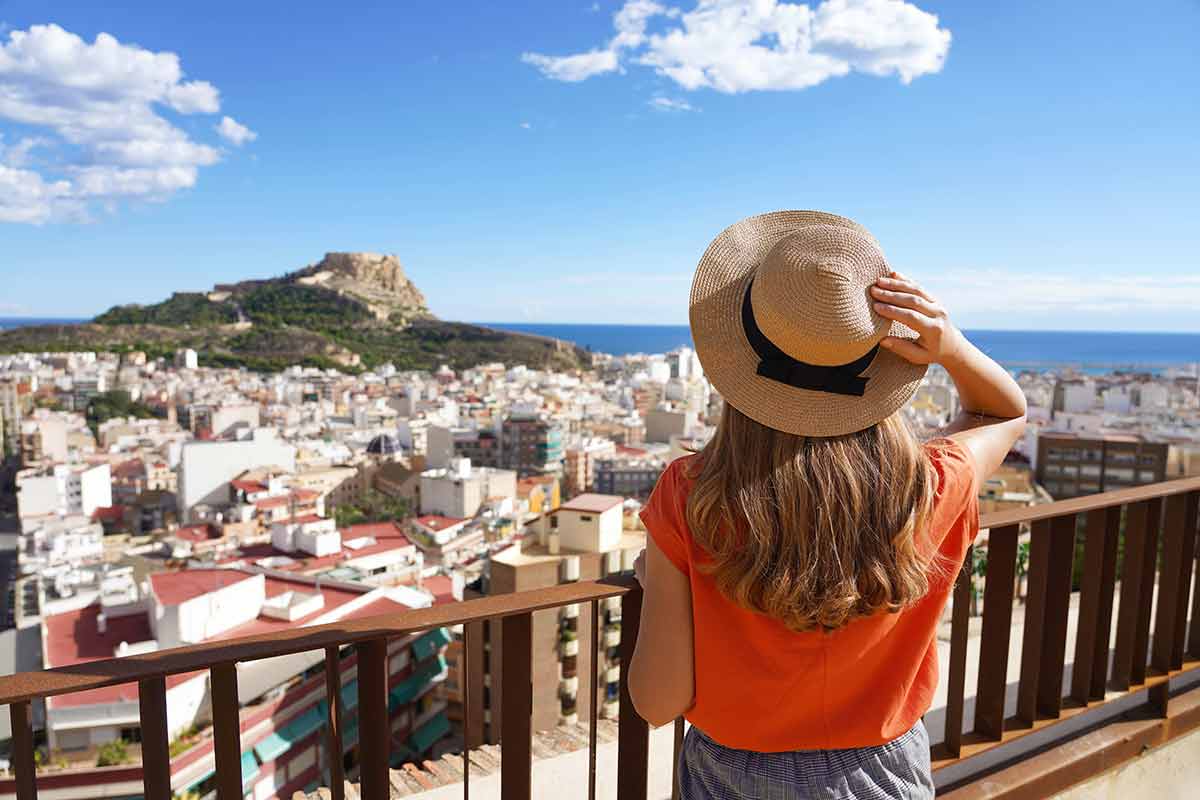
- Alicante: Secret Flavors Food Tour – eat like a local and discover the best tapas and snack spots.
- Alicante: Seven Secrets of Alicante Discovery Tour – explore Alicante with a local and find hidden gems you won’t find in guidebooks.
- From Alicante: Roundtrip to Tabarca Island – take a trip to Tabarca Island and admire colourful fish through a glass bottom boat.
20 Things To Do In Alicante
1- Explore Santa Bárbara Castle
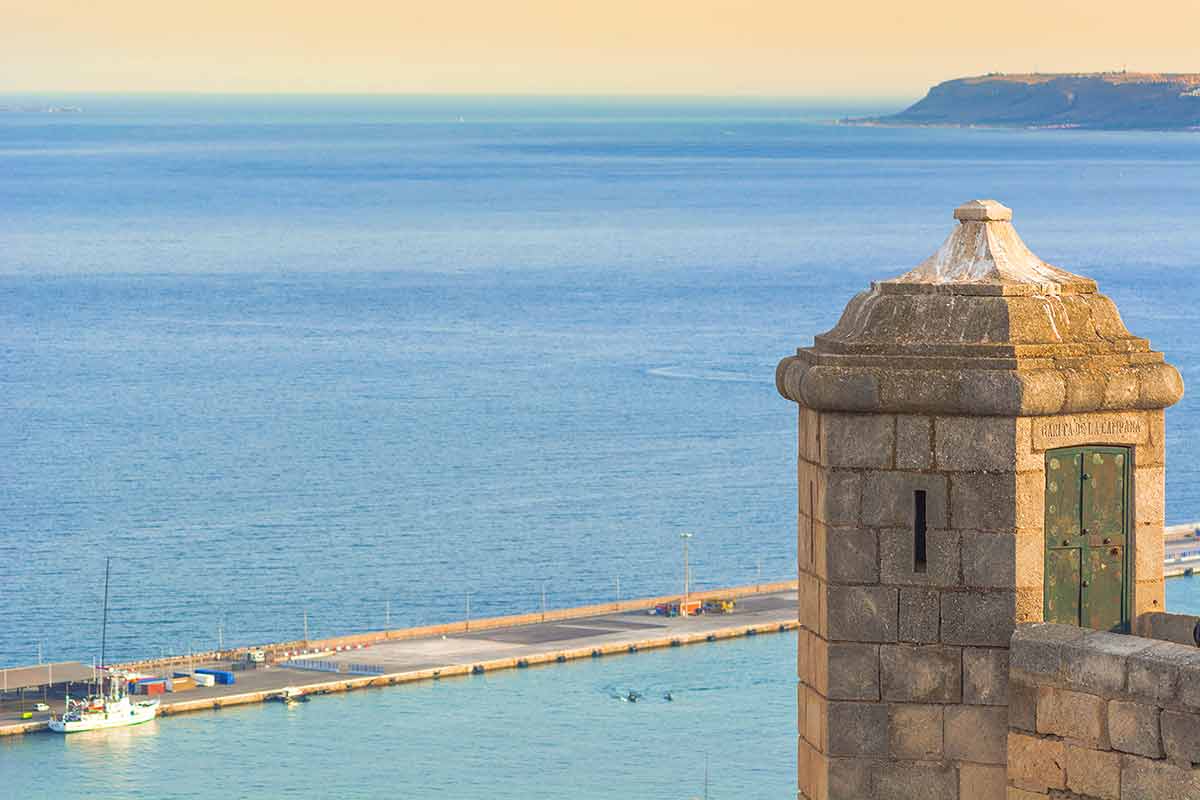
Santa Bárbara Castle sits at 544 feet (166 m) on Mount Benacantil.
It dates back to the 9th century and was originally a Muslim fortification, although Roman and Iberian artefacts have also been found on the mountain slope.
The castle has changed hands many times throughout the ages, from the Moors to the Christians, the Dutch to the British.
It was used to store hoards of gunpowder and was eventually set on fire by the French, causing a massive explosion.
When military activity fizzled out in the 18th century, Santa Bárbara Castle was used as a prison until the early 20th century, when it was abandoned.
In 1960, it opened its doors to the public.
Touring the castle, you can see the varied architecture from numerous reconstructions with exhibits and artefacts.
It includes prison cells, torture devices, knights in armour dotted throughout and cannons lining the highest wall.
The views from Castle Santa Bárbara are spectacular, overlooking the city of Alicante and the beautiful Mediterranean Sea.
Santa Bárbara Castle is at 8GXC+HQ Alicante, Spain.
Recommended tour: Alicante: Craft Beer Tasting at Santa Barbara Castle
2- Visit The Archaeological Museum Of Alicante
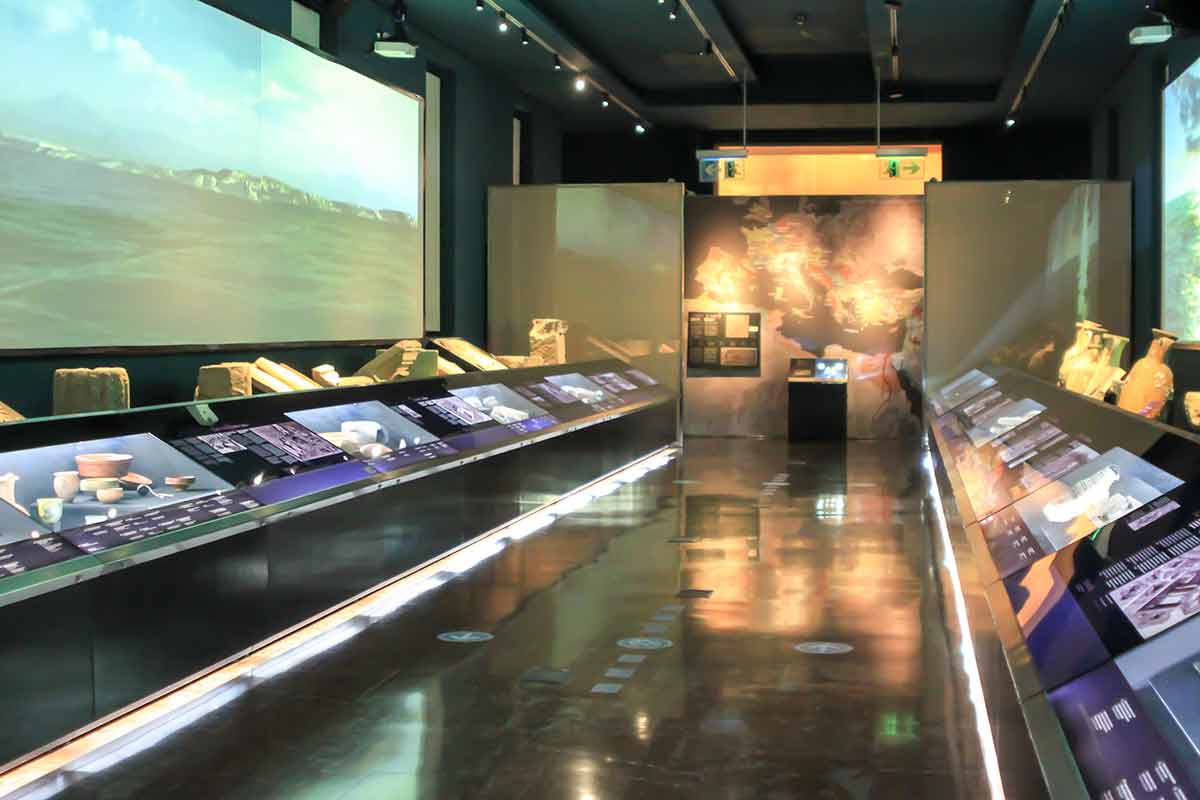
The Archaeological Museum of Alicante (known as MARQ) is housed in the former site of San Juan de Dios Hospital.
The building itself is beautiful and grand from the outside, surrounded by a low wall.
Inside the wall is a tranquil square with a charming café.
The museum has a very well-organised modern layout, with displays divided into eight wings.
There are permanent and temporary exhibits tracing the history of Alicante.
MARQ has prehistoric pieces dating back 100,000 years, Iberian ceramics and Roman and Middle Ages artefacts shedding light on the lives of past civilisations.
The museum has three galleries showcasing the archaeological process with recreations of a Gothic church excavation, a cave excavation and an underwater excavation.
MARQ is just the right size.
You can see the exhibits in an hour or two and have plenty of time to continue exploring Alicante.
MARQ is at Pl. Dr. Gómez Ulla, S/N, 03013 Alacant, Alicante, Spain.
Recommended: Alicante: Villajoyosa Gran Circus Maximus Ticket with Dinner
3- Fall In Love With El Barrio Santa Cruz
El Barrio Santa Cruz is Alicante’s charming Old Town, nestled at the base of Mount Benacantil.
It is my favourite spot in the city.
I love Old Towns, and Spain has no shortage of them.
This little gem of a neighbourhood sits right in Santa Bárbara Castle’s shadow.
From the street, just above Plaza del Carmen, a cobblestone staircase leads you to Santa Cruz.
This car-free neighbourhood is brimming with rows of whitewashed, interconnected houses adorned with colourful accents, potted plants and a maze of narrow alleys and staircases.
The folks who live there have small patios outside their homes.
They love to sit outside and socialise with their neighbours.
Winding your way to the top of town, you’ll find Ermita de la Santa Creu d’Alacant.
This peaceful plaza has a chapel and provides some of the best views of Alicante and the sea.
In the evening the chapel cross is lit with a bright green, neon light.
I highly recommend stopping at one of the little restaurants along the main staircase that leads to the neighbourhood.
Enjoy a drink and a taste of Patatas Bravas before falling in love with the Old Town.
Ermita de la Santa Creu d’Alacant is at C. Diputado Auset, 27, 03002 Alicante, Spain.
Recommended tour: Alicante Charming Villages Tour: Villajoyosa and Altea
4- Take A Stroll Along El Carrer De Bolets
Even in the streets of Alicante, you can find a healthy dose of whimsy.
El Carrer dels Bolets (Mushroom Street) is an enchanting yellow-bricked pedestrian street lined with towering toadstools, each with its own personality, topped with snails and caterpillars.
There are also short toadstool houses where you can walk inside to snap fun photos.
You have to see it to believe it.
Alongside the toadstools, this little piece of wonderland includes numerous shops selling unique locally handcrafted goods and a variety of cafés and restaurants.
Wouldn’t you like to stop and enjoy a drink in a forest of toadstools?
If you’d like a snack while strolling through the toadstools, I recommend grabbing a traditional Argentinian empanada from Jimmy Churri.
Follow it up with a delicious sweet treat from Salt in Cake, directly across the way.
El Carrer De Bolets is at C. San Francisco, 30, 03001 Alacant, Alicante, Spain.
Jimmy Churri is at C. San Francisco, 56, 03001 Alacant, Alicante, Spain.
Salt in Cake is at C. San Francisco, 61, 03001 Alacant, Alicante, Spain.
5- Have A Drink In Plaza Gabriel Miró
Alicante is dotted with many gorgeous, peaceful plazas.
Plaza Gabriel Miró is undoubtedly one of the most beautiful with its abundance of greenery.
The plaza was built in the 19th century and was originally named Plaza de Las Barcas because of its position in front of the port.
Eventually, it was named after the 19th-century writer Gabriel Miró Ferrer.
The standout feature of the plaza is undoubtedly the immense, ancient ficus trees with their intricately tangled trunks and impressive, expansive canopy.
In the centre of the plaza stands La Aguadora, a famous fountain with a sculpture of a woman pouring water from a pitcher.
Surrounding it are benches among the foliage, to sit and enjoy the surroundings.
As with everywhere in Spain, tapas bars and restaurants line the plaza, where you can sit in the shade of the ficus canopy while enjoying Spanish delicacies.
Plaza Gabriel Miró is at Pl. Gabriel Miró, 5, 03001 Alicante, Spain.
Recommended tour: Vineyards of Alicante: Wine Tasting Tour
6- Shop At Alicante Central Market
Alicante Central Market is a market lover’s paradise.
The market has been open since the beginning of the 20th century and is housed in a spectacular Valencian Modernism-style building.
Nearly 300 stalls spread over two floors with massive stained glass windows that create a natural lighting effect.
This market is famous for its wide range of fresh items with unmatched quality, some of which are hard to find elsewhere.
Walking between the bustling stalls is a feast for the senses.
There is a cornucopia of fruit, vegetables, fresh and cured meats and fish, cheese, oils and gourmet items available in the market.
You’ll also find a plethora of ready-made tapas for a bite on the spot.
Alicante Central Market is at Av. Alfonso El Sabio, nº 10, 03004 Alicante, Spain.
Recommended tours:
- Alicante: Central Market Guided Food Tour with Tapas Bars
- Food Walking Tour with Wine Tasting and Tapas
- Beer Spa Experience with Tastings and Snacks
7- Visit The Ocean Race Museum
The Ocean Race Museum on the Port of Alicante is a tribute to the world’s toughest and most prestigious sailing event.
This triennial round-the-world event pushes off from the Port of Alicante.
The Museum covers the history of the legendary Ocean Race and the challenges undertaken by sailors who embark on this wild journey.
Interactive exhibits are included, showcasing the technology used to make such a race possible.
The Ocean Race simulator is perhaps the most thrilling feature.
Visitors can experience the sensation of intense sailing conditions and challenge themselves to navigate through the rough seas.
After a visit to the museum, enjoy a walk along the port’s palm tree-lined promenade.
Benches are placed throughout for relaxing and boat-gazing.
If you need any information for your time in Alicante, the Alicante City Tourist Office is at the beginning of the port.
The Ocean Race Museum is at Mlle. Levante, 10, 03001 Alicante, Spain.
The Alicante City Tourist Office is at Marina Deportiva, Mlle. Levante, 6, 03001 Alicante, Spain.
8- Take A Day Trip To Tabarca Island
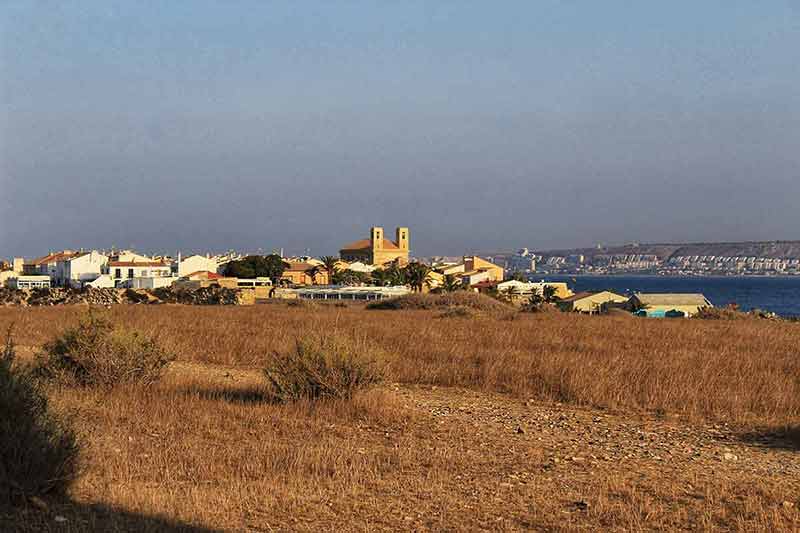
Tabarca makes for a great one-day island getaway.
12.5 miles (20 km) from the Port of Alicante, the tiny car-free island of Tabarca is the only inhabited island in the Valencia Region, with just over 50 residents.
Tabarca’s history is infused with piracy.
Since the 15th century, it was a haven for Barbary pirates who raided nearby shores.
In the 18th century, King Charles III of Spain called for the island’s fortification and resettlement, ending piracy and establishing a fishing village, much like what you can see today.
Tabarca is divided into two parts.
The town sits on the western part of the island with a tiny grid of cobbled streets and incredibly charming fishing houses with blue accents.
The fortification wall still lines this part of the island.
The eastern part is a desert-like nature reserve, complete with walking paths.
Regardless of where you find yourself on the island, there are a variety of beaches to escape the heat.
The island is surrounded by a reef, making snorkelling a popular activity.
Ferries depart from the Port of Alicante multiple times daily, providing easy access to the island.
Recommended tour: Alicante: 6-Hour Catamaran Cruise to Tabarca Island
9- Hike To The Top Of Serra Grossa
Serra Grossa is a small mountain range with an elevation of 528 feet (161 m) northeast of Alicante centre.
It’s a very important landmark for the city.
Remains of a Bronze Age settlement dating back to 1800 BC have been found on its slopes.
Excavated ceramics and flint tools are displayed in the Archaeological Museum Of Alicante.
A series of hiking trails run through Serra Grossa, providing an escape from the city while not having to venture too far.
Along the trails, you can see a variety of plant life and stunning panoramic views from the top.
Trenches and guardhouses from the Spanish Civil War can also be found throughout.
Serra Grossa is not a difficult hike, but it’s best to be equipped with decent shoes and plenty of water.
Catching a sunset from the top is truly unforgettable.
Recommended tour: Alicante: Water Canyoning in Gorgo de la Escalera Ravine
10- Enjoy The Views From Playa Albufereta And Playa Almadraba
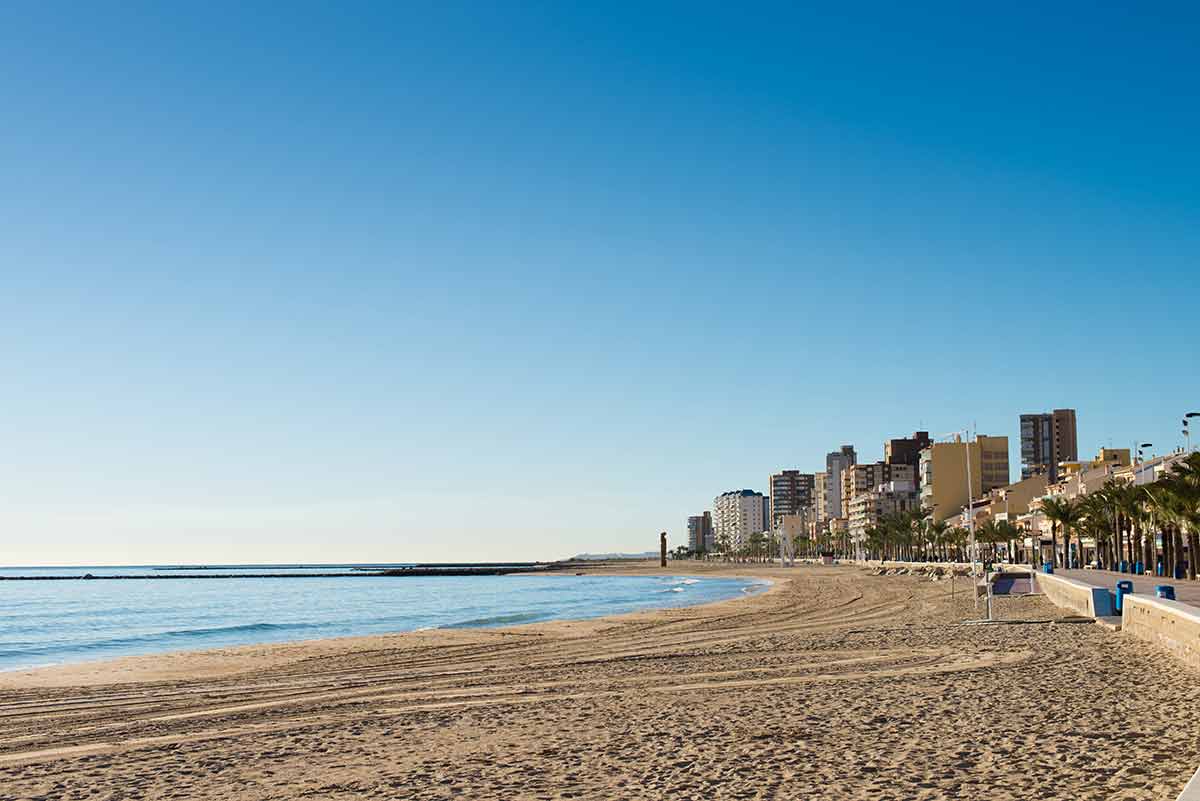
Playa de la Albufereta and Playa de la Almadraba are two small beaches northeast of Alicante centre.
They are tucked in a small nook of Alicante Bay which makes for calm waters, easy swimming and a smooth launch for paddle sports.
A peaceful walkway connects the two beaches with a nautical club in between.
The ruins of a Roman fish farm and cistern sit next to Playa de la Albufereta.
You can enjoy a swim alongside ancient history.
What I love about these two beaches is the unique view.
While they are outside of the hustle and bustle, they provide a great view towards the city and of the towering Serra Grossa with Santa Bárbara Castle just beside it.
The neighbourhoods just behind Playa de la Almadraba are Cap de L’Horta and Playa De San Juan.
This area is one of my favourites.
It has everything you need, including great supermarkets.
If you need a bit of respite from the busy city, this is a great place to be.
Recommended:
- Alicante: Boat Trip and Parasailing Experience with Drink
- Alicante and Santa Pola: Tandem Paragliding Flight
- Alicante: Flyboarding Experience with Instructor
11- Visit The Basilica Of Santa Maria Of Alicante
The Basilica of Santa Maria is the oldest active church in Alicante.
This Valencian Gothic-style basilica dates back to the 14th century, built over the remains of a mosque.
The Basilica was rebuilt after a fire in the 15th century and has had many additions over the centuries, creating the eccentric look it has today.
Its Baroque exterior is accompanied by two asymmetrical towers, one built in the 14th century and the other in the 18th century.
Its stunning doorway is adorned with an intricate sculpture of the Virgin Mary.
You can’t miss it while strolling past in the street.
The interior is truly a spectacular site.
It has one nave with six side chapels between buttresses, a gold-detailed 18th-century Rococo-style altar, and Gothic-style details surrounding it.
A trip to Alicante is not complete without visiting this beautiful Basilica.
The Basilica Of Santa Maria Of Alicante is at Pl. Sta. María, 1, 03001 Alicante, Spain.
Recommended tours:
- Alicante: Private custom tour with a local guide
- Alicante: Private Castle, Old Town, and Churches E-Bike Tour
12- Have Fun At Museo De Fogueres
Every year since the 1920s, the city hosts the Hogueras de Alicante (Bonfires of Alicante) to mark the summer solstice.
It features towering monuments and ninots (caricatures) made of flammable materials, some reaching 30 feet tall.
The week-long festival includes parades and music, ending in the symbolic burning of the monuments and ninots.
At Museo de les Fogueres (Bonfire Museum), you can see the collection of ninots that were saved from the fires.
The museum preserves and showcases the unique tradition and history of the annual bonfires.
Each room of the museum hosts monuments through the ages, from the earliest ninots created in the 1920s to the most current ones.
See how these colourful, over-the-top caricatures have changed from year to year.
Museo De Fogueres is at Rbla. de Méndez Núñez, 29, 03002 Alicante, Spain.
13- See The Iconic Cathedral Of San Nicolás
With any aerial view of Alicante, it’s impossible not to notice The Cathedral of San Nicolás’ intricate blue dome that dominates the scene.
This beautiful gem stands proudly in the middle of the city.
The Cathedral was built in the 17th century in the Herrerian Renaissance style on top of a former mosque (much like the Basilica of Santa Maria).
The front of the cathedral looks quite simple, but what really stands out is its 15th-century Gothic cloister.
It dates back to an earlier medieval church and connects to the cathedral through two grand Baroque doors.
Its floor plan is in the shape of a Latin cross.
Inside the cloister, there’s a lovely little garden with a quiet and serene atmosphere.
This calm space is a stark contrast to the noisy and busy streets that surround it.
The Cathedral of San Nicolás is at Plaza de, Pl. del Abad Penalva, 2, 03002 Alicante, Spain.
14- Have A Beach Day At Playa San Juan
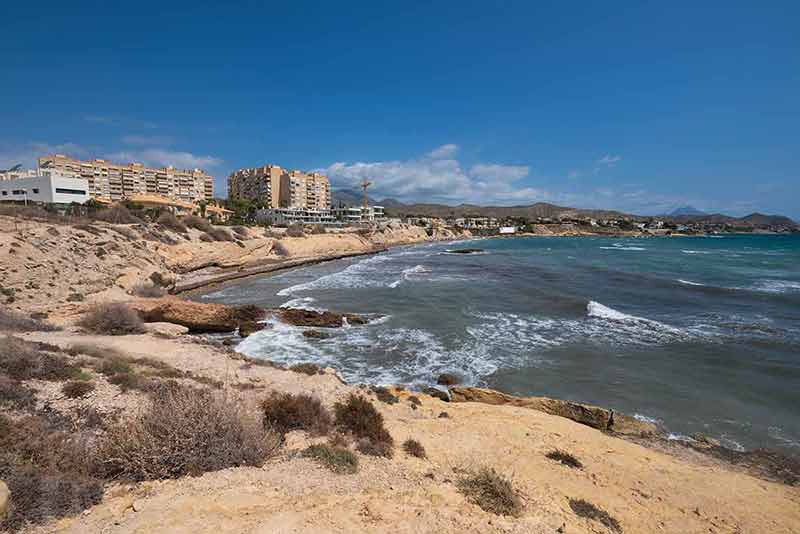
Just on the other side of the Cap de L’Horta neighbourhood is Playa San Juan.
Undeniably my most favourite beach in the province, it’s a quick tram ride from Alicante city centre.
Playa San Juan boasts 4 miles (6.5 km) of unbroken beach and a large, soft, powdery sand area.
Even when it’s busy, there is room for everyone.
It connects to Playa Muchavista.
A delightful promenade with plenty of bars and restaurants runs the entire length.
There are even a few bars right on the beach.
Playa San Juan is a Blue-Flag beach, which means it’s incredibly safe, clean and well-maintained.
So whether you wish to relax and bask in the Mediterranean sun or go for a stroll along the shore or promenade, spending time on Playa San Juan is a must-see during your time in Alicante.
Recommended tours:
- Alicante: Calas and Beaches Bike Tour with Snorkeling
- Alicante: E-Bike Coast Tour, Román Fishpond and Snorkeling
15- Stroll Through San Fernando Castle
San Fernando Castle was introduced to me as “the castle that was never a castle”.
Built on Mount Tossal in 1812 for the Spanish War of Independence, it was meant as a prison and reinforcement for Santa Bárbara castle.
The construction was rushed for the arrival of the French, who were supposed to occupy the castle.
But they only stayed for a mere 24 hours, enough time to set off a few cannons.
Then they fled to prepare for battle with Russia, never to return.
San Fernando Castle never saw any military action at all.
This was probably for the best because the hurried construction left much to be desired.
Cracks and flaws began to show very soon after, much to the resentment of the locals.
It was an expensive project that the whole town worked together to pull off.
The castle remains are left and can be fully explored, with expansive views of Alicante and the surrounding area from the castle wall.
Alongside San Fernando Castle is Mount Tossal Park, a luscious green space with walking trails throughout.
San Fernando Castle is at Mont Tossal, 03005 Alacant, Spain.
Mount Tossal Park is at C. Escultor Bañuls, 03009 Alicante, Spain.
16- Explore The Rock Formations Of Cap De L’Horta
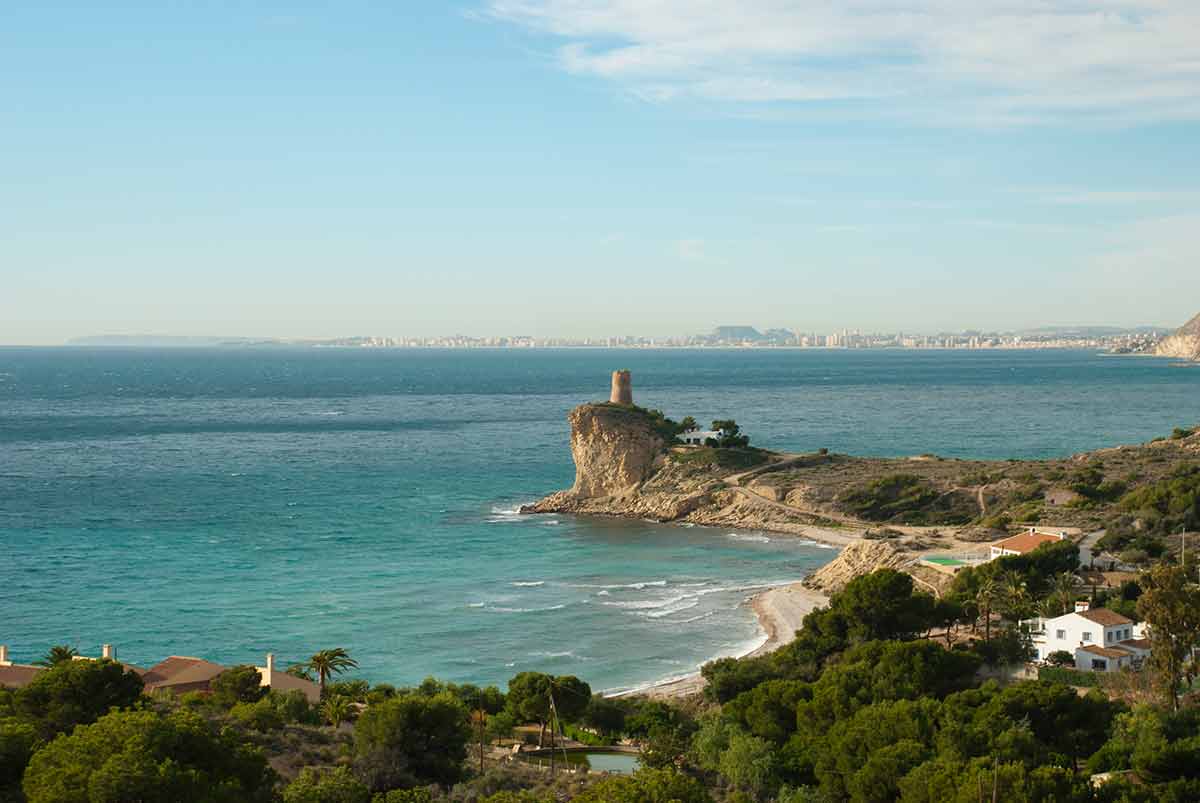
Cap de l’Horta occupies the northern tip of the Bay of Alicante.
It consists of a neighbourhood, a nature reserve and spectacular rock formations.
A walking path starting at Playa de la Albufereta wraps all the way around the tip of this rocky horn to Playa San Juan on the other side.
Natural pools have been formed in the rock, creating perfect secluded swimming holes to one side of the path.
A wall of limestone carved with fantastic shapes from the wear and tear of the waves lines the other side.
The rock formations just after rounding the point are perhaps the most spectacular (and my favourite spot).
Long fingers of rock jut out into the water, creating flat, narrow piers you can walk along.
The Earth looks like it was scraped millions of years ago, leaving behind this incredible shore.
Views from the ground almost do it no justice (have a look from Google Earth).
A micro beach sits between each rock finger that you can have all to yourself! Or pick a narrow pier and sit at the tip of it for a picnic, and watch the sea flow by.
Recommended tours:
- Alicante: Coasteering Adventure on Torres de la Villajoyosa
- Alicante: Canelobre Caves Tour with Transport
17- Learn The History Of Bullfighting At Museo Taurino
Bullfighting has been a part of Alicante’s culture for hundreds of years, with the first documented bullfight in 1700.
The events were held in various locations across the city until the famous Plaza de Toros was built in 1848.
This bullring is one of the oldest active arenas in the Valencian Community.
Museo Taurio (the Bullfighting Museum) is in Plaza de Toros and offers an insightful perspective on the controversial subject of bullfighting.
It houses an array of historic artefacts such as matador costumes through the ages, vintage posters, a collection of bullfighting literature and much more.
Visitors can tour the bullring itself, which is open to the public for a few hours each day.
As well as bullfighting, this impressive structure is also used for sporting events and concerts.
Plaza de Toros is at Plaça d’Espanya, 7, 8, 03004 Alacant, Alicante, Spain.
18- See The Famous Roman Ruins In El Campello
Illeta dels Banyets is a fascinating archaeological site that spans many centuries of history, displaying a blend of ancient cultures.
It’s one of the earliest excavated archaeological sites of Alicante.
The site sits along a small peninsula in El Campello, a town just a few minutes away from Alicante city.
Excavations have revealed levels of history beginning with Neolithic oval houses and Bronze Age underground tanks, tombs and numerous artefacts.
The Iberian era follows with the remains of a pottery workshop, complete with ovens, a housing estate and temples.
Most prominent are the remains of the Roman period.
An intricate Roman city with thermal baths was constructed on top of the Iberian settlement.
Intricate hand-carved rock formations lie at the tip of the small peninsula.
Local legend has it that this was a lavish bathing spot for a Moorish queen.
In reality, these formations were a Roman fish farm.
Illeta dels Banyets still affectionately holds the nickname “The Queen’s Baths”.
Illeta dels Banyets is at Partida Almadrava, 03560 El Campello, Alicante, Spain
19- Eat Paella In El Campello
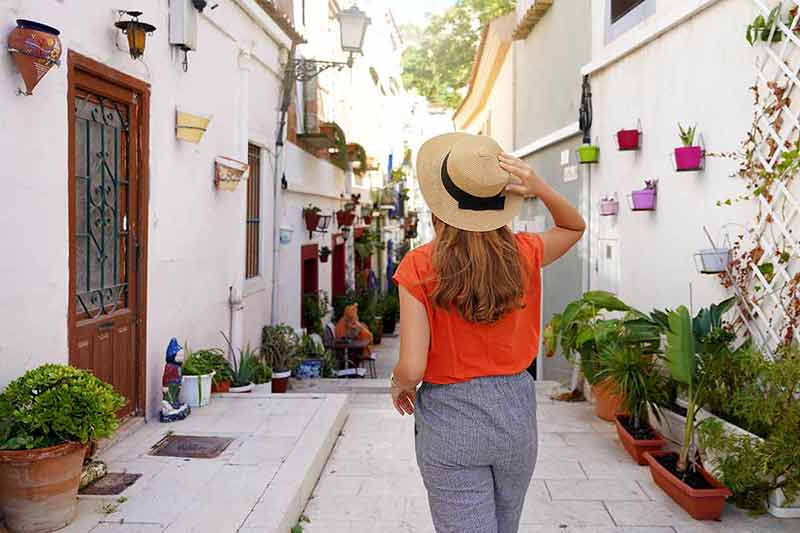
I think it goes without saying that a trip to Spain is never complete without paella, the country’s national dish.
And there’s no better place for seafood paella than Spain’s Costa Blanca, where the seafood is as fresh as can be, especially if the restaurant is right in a harbour.
El Chiringuito Restaurant is right beside Club Náutico de Campello, in El Campello harbour.
It boasts some of the best seafood in the area, specialising in paella.
The restaurant provides a relaxed and truly Mediterranean atmosphere with seating right beside the water, perfect for boat-gazing as you dine.
El Chiringuito Restaurant is at Carrer de la Illeta, s/N, 03560 El Campello, Alicante, Spain.
Recommended tours:
20- Walk Along Esplanade De España
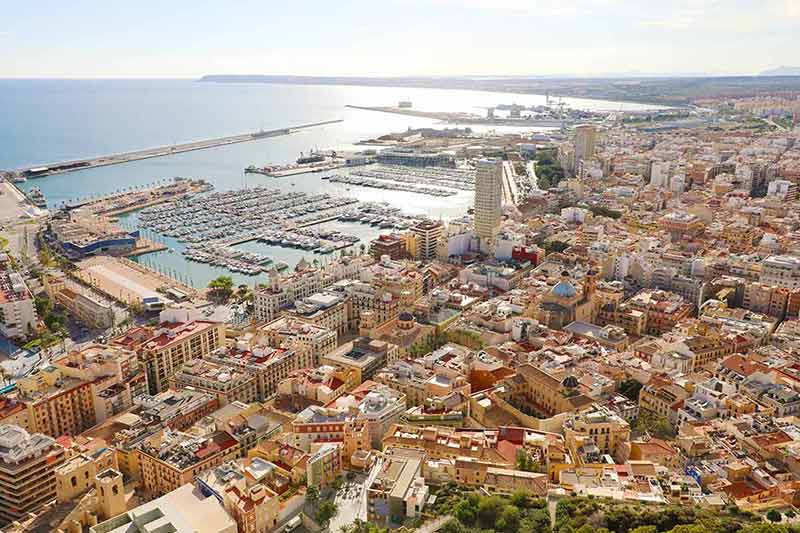
The Explanada de España in Alicante is, without a doubt, the city’s most popular place for a relaxed walk.
It runs right alongside the harbour, from the ancient ficus trees at Parque de Canalejas to the flowing fountain at Plaza Porta del Mar.
The palm tree-lined promenade is paved with an intricate mosaic that mimics the waves of the Mediterranean, making it the perfect spot for a casual stroll while enjoying the sea views.
Magicians, musicians, mimes and painters occupy the promenade, showcasing their talents.
Craft and souvenir stalls offer a variety of accessories, jewellery, leather goods, and textiles.
From Plaza Porta del Mar you get a perfect view of Casa Carbonell, a mansion built in the Beaux Arts style between 1922 and 1925.
Originally built for textile entrepreneur Enrique Carbonell, this historic building once witnessed a unique event when, in its opening year, a light plane from Algiers unexpectedly crashed into one of its balconies.
Parc Canalejas is at Av. de Ramón y Cajal, 03003 Alicante, Spain.
Plaza Porta del Mar is at Pl. Prta del Mar, 3, 03002 Alicante, Spain
Casa Carbonell is at Passeig Esplanada d’Espanya, 1, 03002 Alacant, Alicante, Spain.
Recommended tour: Alicante: City Highlights Walking Tour with Drinks
Love Spain? Read these posts:
- 27 Spanish Shows On Netflix
- 20 Fairytale Castles In Spain
- 30 Landmarks in Spain
- 20 Places To Visit In Spain In Winter
- 20 Best Beaches In Spain
- An Amazing Andalusia Road Trip
- 20 Things To Do In Ibiza
- 20 Things To Do In Tenerife
- 21 Things To Do In Lanzarote
- 21 Spanish Drinks To Try
- 20 Things To Do In Madrid At Night
- 20 Day Trips From Madrid
- Best Time To Visit Spain
- 20 Cities in Spain
- Renting A Car In Barcelona
- 20 Things To Do In Seville
- 20 Things To Do In Granada
- 20 Things To Do In Zaragoza
- 20 Things To Do In Palma
- 20 Tours In Spain
- 20 Things To Do In Alicante
- 20 Spanish Food / Dishes
- 20 Things To Do In Ronda
- 20 Things To Do In Cadiz
- 20 Thing To Do In Benalmadena
- 20 Things To Do In Torremolinos
- 20 Landmarks In Barcelona
- 5 Day Trips From Barcelona
- Barcelona Bike Tour
- 10 Things To Do In Bilbao
- 12 Things To Do In San Sebastian
- 10 Things To Do In Oviedo
- Storybook Village of Santillana del Mar
- 20 Things To Do In Gran Canaria
- 20 Things To Do In Barcelona At Night
- Christmas in Spain
- 20 Things To Do In Malaga
- 20 Things To Do In Marbella
- 20 Things To Do In Valencia
- Where To Stay In Valencia
- Ibiza At Night
- 20 Things To Do In Ibiza
- 20 Things To Do In Toledo
- Where To Stay in Barcelona
- 20 Things To Do In Segovia
- Where To Stay in Tenerife
- Where To Stay in Madrid
- Where To Stay In Mallorca
- Where To Stay In Ibiza
- 15 Things Spain Is Famous For
Plan Your Trip

Rent A Car – Find the best car rental rates at Discover Cars. They compare car hire companies to provide you with the best deal right now.

Find A Hotel – If you’re curious about this article and are looking for somewhere to stay, take a look at these amazing hotels.

